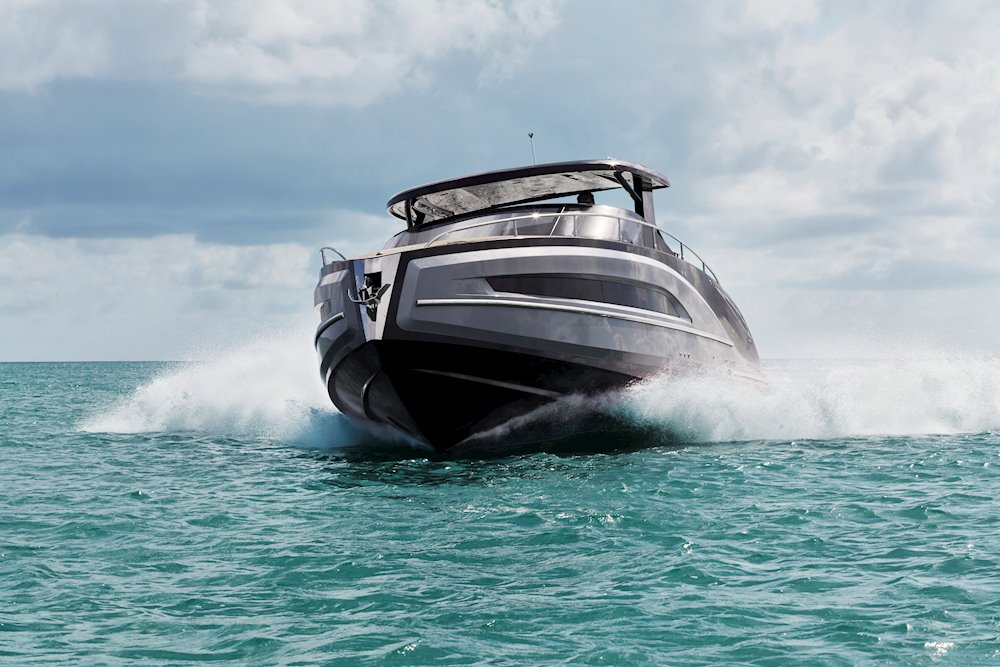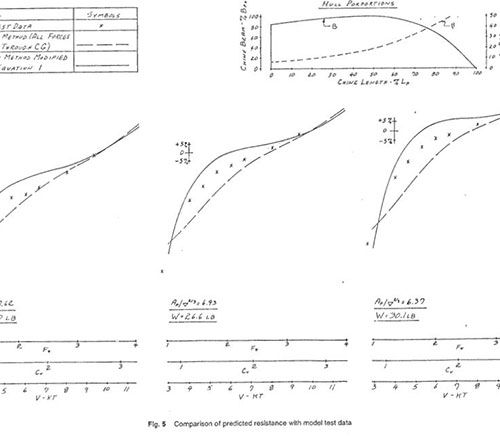DLBA UNIVERSITY
Small-Craft Power Prediction
AUGUST 24, 2019
By Donald L. Blount and David L. Fox
A valid performance prediction technique for small craft is an invaluable tool not only for the naval architect, but also for the operators and builders. This presentation describes the methodology for making speed-power predictions for hard-chine craft of the types found in the offshore, military, and recreational applications.

The distinct advantage of this method is that existing technical data have been organized into a logical approach and areas of limited data have been overcome by the presentation of engineering factors based on model tests and full-scale trials of specific hull forms. This speed-power prediction method accounts for hull proportions, loading, appendage configuration, propeller characteristics (including cavitation), and resistance augmentation due to rough water.
In case you would like to receive the full paper or discuss about this subject, please contact Jeffrey Bowles

References
1. Hadler, J. B., “The Prediction of Power Performance on Planing Craft,” Trans. SNAME, Vol. 74, 1966.
2. Hadler, J. B. and Hubbie,E. N., “Prediction of Power Performance of the Series 62 Planing Hull Forms,” Trans. SNAME, Vol. 59, 1971.
3. Du Cane, P., High-speed Small Craft, John de Graff, Inc., Tuckahoe, New York.
4. Savitsky, D., Roper, J.. and Benen, L.. “Hydrodynamic Development of a High-speed Planing Hull for Rough K7ater,” 9th Symposium on Naval Hydrodynamics, Aug. 1972.
5. Savitsky, D., “Hydrodynamic Design of Planing Hulls,” MARINE TECIINOLOGY, Vo1. 1. No. 1. Oct. 1964.
6. Clement. E. P. and 13louni, D. L., “Resistance Tests of a Systematic Series of Planing Hull Forms,” Trans. SNAME, Vol. 71,1963.
7. Hubble, E. N., “Resistance of Hard-Chine, Stepless Planing Craft with Systematic Variation of Hull Form, Longitudinal Center of Gravity, and Loading.” NSRDC Report 4307, .4pril1974.
8. Holling, H. D. and Hubble, E. N., “Model Resistance Data of Series 6.5 Hull Forms Applicable to Hydrofoils and Planing Craft,” NSRDC Report 4121, May 1974.
9. Hadler, J. B., Hubble. E. N., and Holling, H. D., “Resistance Characteristics of a Systematic Series of Planing Hull Forms-Series 65,” SNAME, Chesapeake Section, May 1974.
10. Kapryan, W. J. and Boyd, G. M., .Jr., “Hydrodynamic Pressure Distributions Obtained During a Planing Investigation of FiveRelated Prismatic Surfaces,” NACA Technical Note 3477, Sept. 1956.
11. Hoerner, S. F., Fluid Dynamic Dray, published by the author. Midland Park, N. J., 1965.
12. Gregory, D. L. and Dobay, G. F., “The Performance of High Speed Rudders in a Cavitating Environment,” SNAME Spring Meeting, April 1973.
13. Mathis, P. B. and Gregory, D. L., “Propeller Slipstream Performance of Four High-speed Rudders Under Cavitating Conditions,” NSRDC Report 4361, May 1974.
14. Fridsma. G.. “A Systematic Study Of The Rough-water Performance of Planing Boats,” Davidson Laboratory Report R-1275. Nov. 1969.
15. Fridsnra, G., “.4 Systematic Study of the Rough-Water Performance of Planing Boats (Irregular Waves-Part II),” Davidson Laboratory Report K-1495. M:mh 1971.
16. Blount, D. L., Stuntz, G. R., Gregory, D. L.. and Frome. M. .I., “Correlation of Full-Scale Trials and Model Tests for a Small Planing Boat,” Trans. RINA. 1968.
17. Blount, D. L.. “Resistance and Propulsion Characteristics of a Round-Bottom Boat (Parent Form of TMB Series 63),” DTYB Re. port 3000, March 1965.
18. Gawn, R. W. L. and Burrill, I.. C., “Effect of Cavitation On the Performance of a Series of 16-Inch Model Propellers.” Trans. INA. Vol. 99. 1957
Share this article online:
HOW CAN WE HELP YOU?
FEEL FREE TO CONTACT US

DLBA Naval Architects
860 Greenbrier Circle, Suite 201 Chesapeake, Virginia 23320 USA
Phone: 757-545-3700 | Fax: 757-545-8227 | dlba@gibbscox.com
STAY UPDATED
SIGN UP FOR OUR NEWSLETTER
Keep your finger on the pulse of the latest points of focus in naval architecture and engineering: subscribe to DLBA’s concise monthly newsletter. Within it, we briefly describe and picture our latest projects and concepts. We encourage feedback and seek to have our newsletter spark conversation regarding potential collaborations and further advancements as we share our passion for the industry.
